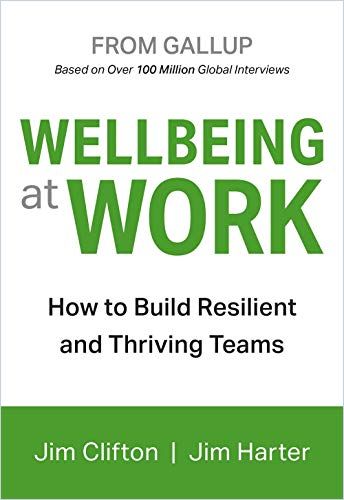Gallup polling aficionados and prolific authors Jim Clifton and Jim Harper analyze data derived from more than 100 million interviews to help leaders improve employee health.

Take Care of Your People
Gallup’s CEO Jim Clifton and the polling company’s chief scientist Jim Harter synthesize data from more than 100 million global interviews to reveal how employee well-being and mental health stand at historic lows. In their succinct textual exploration backed by reams of data, Clifton and Harter detail how business leaders can and must play a meaningful role in reversing this trend. They make a convincing, data-driven argument that when leaders embrace their responsibility to promote the career, social, financial, community and physical well-being of their workforce, business and society benefit.
Mental Health
Clifton and Harter point to a decline in well-being in the United States and elsewhere – one that long preceded the COVID-19 crisis.
A third of Americans are showing signs of clinical anxiety or depression.Jim Clifton and Jim Harter
They cite how so-called US “deaths of despair” more than doubled between 1995 and 2018 – and remind readers that mental health challenges arising from stress and hopelessness lead to a host of problems at work and home. The road back to health, they believe, begins in the workplace, because a good job boosts well-being in myriad ways.
Measuring Employee Health
The company developed its Gallup Net Thriving (GNT) metric in 2005; it asks respondents to rate their well-being on a 10-rung ladder, with “best possible life” representing the top rung and “worst possible life” at the bottom.
One of the single biggest discoveries Gallup has ever made is this: What the whole world wants is a good job.Jim Clifton and Jim Harter
The authors explain how respondents rank their current position and where they expect to be in five years. They urge organizations worldwide to adopt the GNT metric across their workforces.
Five Well-being Factors
Gallup polling revealed five interconnected and additive elements of well-being. These include career well-being; social well-being; financial well-being; physical well-being and community well-being. When you experience career well-being, work motivates you more than your paycheck.
An engaged employee wakes up in the morning thinking about the work they are going to do that day – and that work is interesting and challenging to them.Jim Clifton and Jim Harter
Hating your job, the authors explain, leads to mental and physical health problems, including stress, burnout, increased emergency room visits and even death.
Declining Employee Health
The authors assert that people need, on average, six hours of social time every day. And, they note, isolation or ostracism at work devastates well-being and performance.
People who have at least three or four very close relationships are healthier, have higher well-being and are more engaged in their job.Jim Clifton and Jim Harter
Clifton and Harter lament that COVID-19 worsened already high levels of social isolation. They recommend that leaders nurture belonging and collegiality, even when individuals or teams work remotely. They further suggest connecting new hires to their peers during onboarding and finding ways for workers to spend time together, virtually or in person, because togetherness builds well-being, trust and engagement – its own return on investment.
Clifton and Harter report that almost half of US workers live paycheck to paycheck. They insist leaders must compensate workers well and competitively, with good benefits.
The perception that you have more than enough money to do what you want to do has three times the impact of your income on your overall well-being. Jim Clifton and Jim Harter
Workers’ physical health, particularly in America, Clifton and Harter disclose, has declined precipitously over the past several decades, despite advances in health care and pharmaceuticals. Leaders should, they argue, promote exercise and healthier eating by offering gym memberships, nutritious snacks and healthful cafeteria menu options, and design office space that encourages movement.
Purposeful Work
Clifton and Harter exhort leaders to infuse work with shared purpose and meaning. People feel safer and more connected to their local communities, the authors discovered, when they contribute – and the same rule applies within the workplace community.
On a positive note, Clifton and Harter relate that when people collaborate and innovate, they become more productive, and extend greater trust to one another. A healthy work environment suffused by the five elements of well-being will attract top talent and reduce attrition.
In Germany and the US, Gallup found that people with a bad manager had even worse well-being than those without jobs.Jim Clifton and Jim Harter
Likewise, they caution that your company must mitigate overwork. If an employee is alienated from family, friends and community due to working excessive nights and weekends, your company must intervene.
Companies should promote exercise and physical well-being because they have a social obligation to keep their workers healthy and engaged. To that end, the authors believe firms must give employees meaningful work that plays to their strengths; provide enthusiastic coaches who motivate and encourage; compensate and reward leaders who demonstrate concern; and act to improve worker well-being – from mental and physical to social and financial.
Clifton and Harter assert strongly that leaders must correct conditions that undermine mental health; create a clear company vision and purpose; get rid of rigid policies and meaningless perks; and cull bad managers and management practices.
One-Stop Shopping
Clifton and Harter offer a succinct primer derived from extensive research analysis. Little they unearth is groundbreaking, but their book’s brevity and data-richness become its main strengths – as the authors touch on every major cornerstone of worker well-being. Their simple message is lucid and provides one-stop shopping for leaders seeking to put their workers in the best possible position to succeed. Their advice will probably prove most valuable to new bosses of start-ups and entrenched bosses of older command-and-control companies. The former need guidance at the beginning and the latter need to undo unhealthy habits.
Jim Clifton also wrote The Coming Jobs War and co-authored Born to Build with Sangeeta Badal; he and Jim Harter co-authored It’s the Manager. Jim Harter co-authored Wellbeing with Tom Rath.








